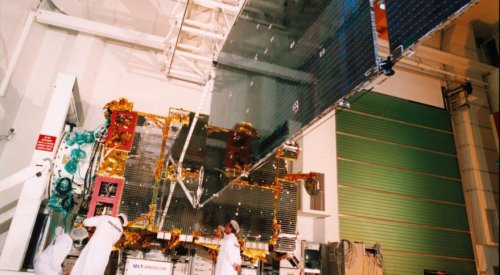Updated at 4:15 p.m. Eastern.
WASHINGTON — SES says its 14-year-old satellite that malfunctioned and strayed from its orbit over the weekend poses no collision or interference danger to other satellites in the vicinity.
AMC-9, a 4,100-kilogram communications satellite orbiting some 36,000 kilometers above North America, “is slowly moving westwards,” and “is in a stable and predictable orbit,” according to an SES statement provided to SpaceNews June 21.
“AMC-9 is being tracked by SES and other agencies,” SES said. “There is no risk of a collision with other active satellites. All relevant operators and agencies have been informed and will receive regular updates from SES.”
Luxembourg-based SES says AMC-9 suffered a “significant anomaly” June 17 but has not identified the cause. SES said the company is working with Thales Alenia Space to trace the source of the malfunction, and how to reestablish communications.
“We have no established telemetry command and control,” SES spokesperson Markus Payer said in a June 21 telephone interview. “We are trying to re-establish that, but it is not yet the case.”
The Space Data Association, a collective of satellite operators that share data on spacecraft locations to prevent collisions and interference, is assisting in disseminating information about AMC-9.
“SES’s Flight Dynamics team have already uploaded the latest ephemeris for AMC-9 into the SDA’s Space Data Center,” Mark Dickinson, SDA chair, told SpaceNews by email June 21. “SDA members’ satellites are already being screened against this ephemeris and will receive notifications if necessary.”
In its statement, SES said the majority of AMC-9’s traffic has been transferred to other SES satellites and that the operator “is working on a long term plan to minimize disruption to our customers that originally used AMC-9.”
Payer said yesterday that such a long term plan could including using capacity on other operator’s satellites for the remaining displaced customers if SES cannot provide suitable alternatives from its own fleet.
- Despite ruble crunch, Gazprom Space Systems still “optimistic against all odds”
- NASA’s Deep Space Network could face telecommunications traffic jam on Mars
- For Rep. Rogers, fighting through a war in space starts with fixing acquisition
- Inmarsat and AVI’s satellite data-relay service exits stealth mode after months of secret, in-space tests
- Yahsat’s Mahmood on Brazil, Africa, Facebook and future satellites
Share with your friends

(0) Comments
This article comments are currently no :(